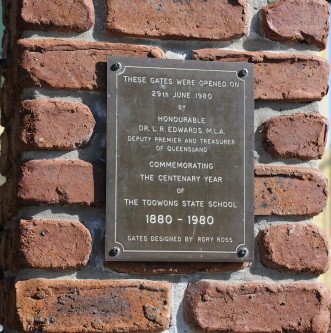 Toowong State School would like to acknowledge the traditional owners of this site – the Jagera and Turrbal people, and pay respect to leaders past and present.
Toowong State School would like to acknowledge the traditional owners of this site – the Jagera and Turrbal people, and pay respect to leaders past and present.
The district of Toowong had attracted many settlers by 1861, and after the Brisbane-Ipswich railway line was constructed in 1874, rapid expansion occurred. Following the growth in population came the demand for education and a school was opened by a Mrs Williams and her daughter.
The Minister for Public Instruction in the government of the day decided that the area would be best served by a state school, and so a new school was built on a site in Aston Street. It opened on 22 January 1880 and only nine years later the school had an enrolment of 350 pupils. Many of the pupils came from great distances, travelling from suburbs including Indooroopilly, Milton, and even from across the river at West End. Due to the increase in population in different areas of the suburb the suggestion was made to move the school to what was fast becoming the centre of the district. It was decided to move the school to its present location. This move occurred during September 1910.
The original school buildings still in use are rooms 9, 10 and 11. The enrolment at the time of the move was just under 300. The school population continued to grow and reached a peak of 895 in 1927. This is an amazing number of students and many of the verandas would have been used as classrooms. In the early 1930s extensive work was done levelling the grounds. The post-war period has seen quite a lot of upgrading and modernising of classrooms and facilities.
The school participated in festivities connecting to the Coronation of the King in June 1911, and, again on the occasion of the visit of the Prince of Wales in August 1920. For this event it was found impossible to make any arrangements for the transit of the scholars to the city either by tram, train or steamer, so there was nothing left but to march the scholars to and from the city, headed by a bugle band. However, the school was fortunate to be allotted one the best positions on the ground, which compensated to some extent.
During the Great War, three teachers went to the front, two earning distinctions. No less than 148 old scholars were known to have served their King and country, 28 of whom paid the supreme sacrifice, and three gaining military honours. A striking circumstance was the fact that this total included in two cases five brothers in arms, the Patterson and Darlington families, while in several other families, four and three brothers enlisted together. Our library houses the cedar honour board from this time.
Today, diversity and inclusion are obvious strengths of the school. The school population includes many international families alongside a small group of deaf children. Our international families contribute a richness of culture to our school community. The school has also established a bilingual/bicultural program to meet the needs of our hearing impaired students, children of deaf adults, and those wishing to undertake their schooling through a combination of Auslan and English.
We have many dedicated class teachers, support staff, and families all aiming to provide the best education for our children. The school celebrated 140 wonderful years in 2020!